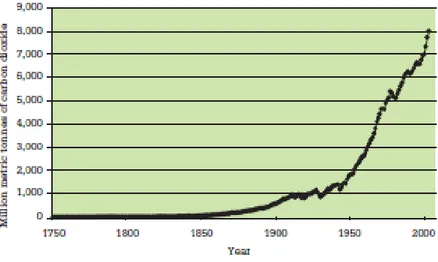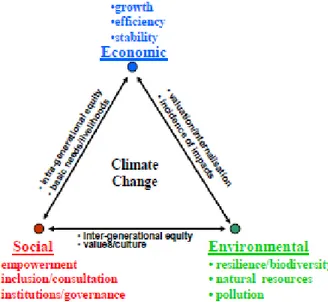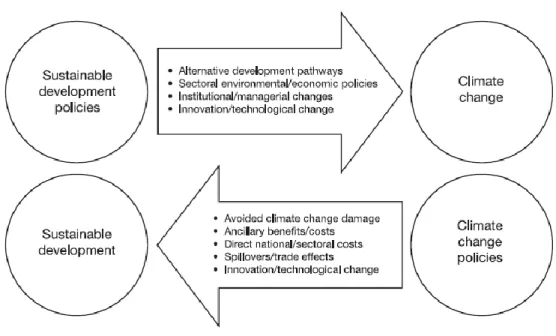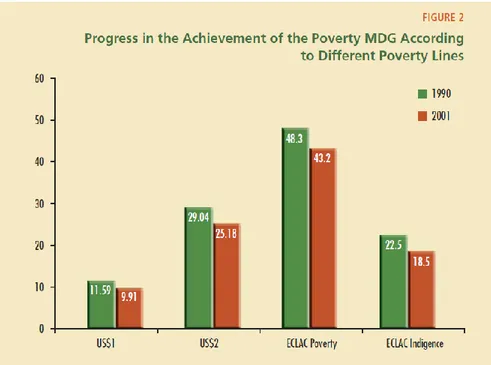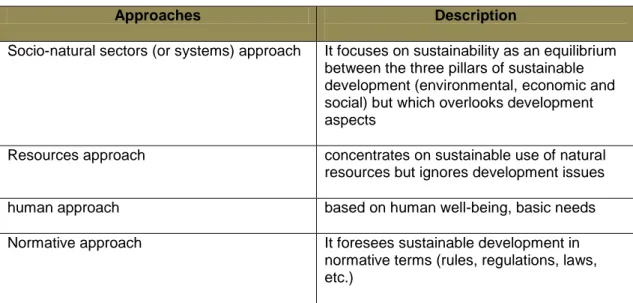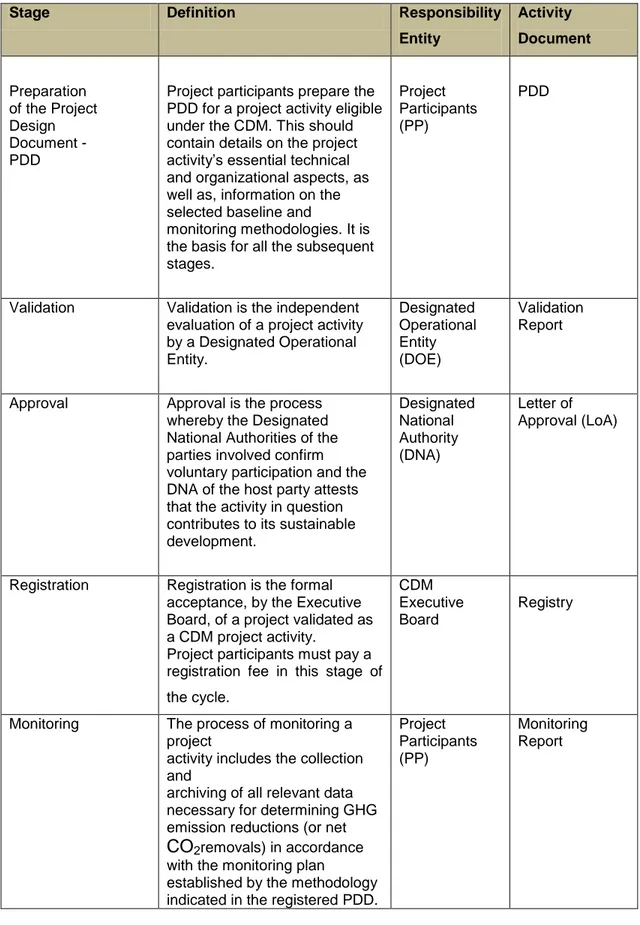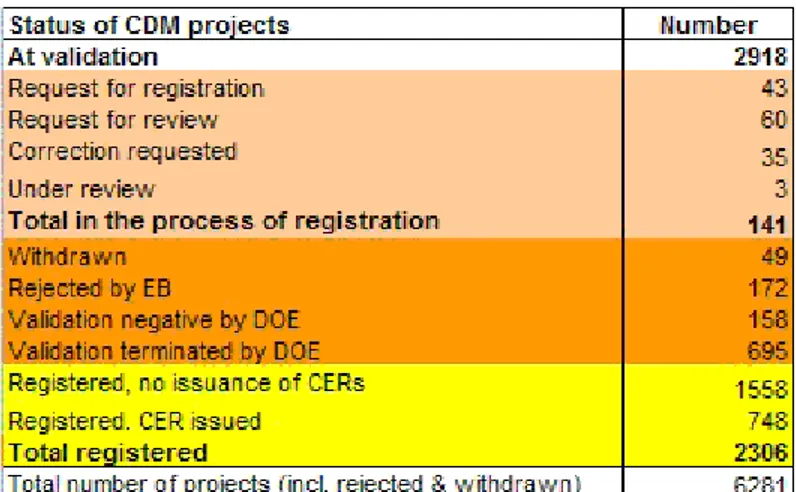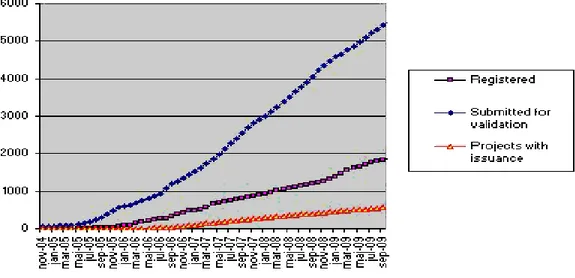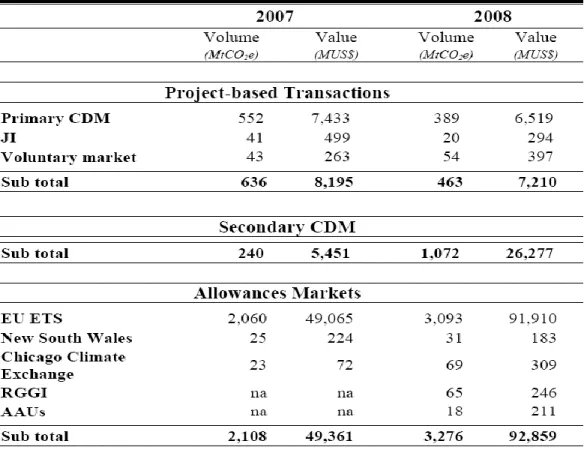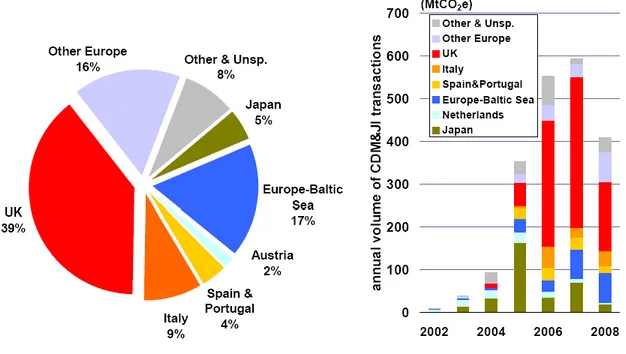1
Università Ca‘ Foscari Venezia Università IUAV di Venezia
Fondazione Scuola Studi Avanzati in Venezia
Dottorato di ricerca d‘eccellenza in ANALYSIS AND GOVERNANCE OF SUSTAINABLE DEVELOPMENT,
23° ciclo
(A.A. 2007/2008 – A.A. 2009/2010)
ASSESSING THE CLEAN DEVELOPMENT MECHANISM
CONTRIBUTION TO
SUSTAINABLE DEVELOPMENT IN MEXICO (2005-2010)
SETTORE SCIENTIFICO DISCIPLINARE DI AFFERENZA
: SECS-P/06 Tesi di dottorato di Simone Lucatello, matricola 955413
Direttore della Scuola di dottorato Tutore del dottorando Prof. Gian Maria Zuppi Prof. Massimiliano Montini
2
ABSTRACT
This dissertation explores the role of the Clean Development Mechanism (CDM), an offset mechanism under the Kyoto Protocol (art. 12) that allows the crediting of emission reductions from Greenhouse Gas (GHG) abatement projects in developing countries, and its contribution to Sustainable Development (SD) in Mexico. One of the growing concerns about the performance of the CDM under current international negotiations for the post Kyoto regime (2012) deals with its weak capacity to deliver on its environmental and SD objectives in countries where it is implemented.
Through a sustainability assessment, the thesis analizes if and how CDM projects in Mexico are fulfilling one of the main objectives for which it was created and to what extent during the period 2005-2010.
The main argument of the thesis – besides the criticism about the efficiency and efficacy of the CDM itself- is that considering the extreme flexibility of SD criteria established by the Mexican government through the Designated National Authority (DNA), CDM proejcts have a relative impact on SD in some key dimensions such as environmental, economical, and to a lesser extent, social one. CDM relation with SD and its contribution in Mexico is however a complex topic to understand, partly due to the vague definition of SD adopted at country level and stakeholders positions towards the CDM itself.
La tesi analizza il ruolo del Meccanismo di Sviluppo Pulito (MSP) - un meccanismo di compensazione previsto nell‘art. 12 del Protocollo di Kyoto che consente l'accredito di buoni di carbonio derivati dalle riduzioni di emissioni di gas a effetto serra (GHG) per mezzo di progetti applicati nei paesi in via di sviluppo - e il suo contributo al miglioramento delle strategie di sviluppo sostenibile (SS) adottate nel caso del Messico. Una delle crescenti preoccupazioni a livello internazionale sulle prestazioni del MSP e per lo stesso futuro del protocollo di Kyoto (pst-2012) é precisamente la sua poca capacità di complementare o raggiungere gli obiettivi ambientali e di SS nei paesi dove viene applicato. Pertanto, attraverso una valutazione della sua sostenibilità, la tesi analizza se e come i progetti del MSP in Messico stanno compiendo con uno degli obiettivi principali per cui è stato creato e in quale misura, nel corso del periodo 2005-2010.
L'argomento principale della tesi, al di lá delle considerazioni sull‘efficienza ed efficacia del MSP per se, è che considerando l'estrema flessibilità dei criteri dello sviluppo sostenbile stabiliti dal governo messicano attraverso la National Designated Authority (DNA), i progetti del MSP hanno un impatto relativo in alcune dimensioni chiave come quelle ambientali, economiche e, in misura minore, in quelle sociali. La relazione tra il MSP e il suo contributo allo SS in Messico è comunque un argomento complesso da analizzare, in parte dovuto alla vaga definizione di SS adottata a livello nazionale e le posizioni assunte dai diversi soggetti interessati alla realizzazione dei progetti nel paese.
3
ACKNOWLEDGEMENTS
This thesis is the outcome of a three-year research process that was possible thanks to the support from different institutions. On one side I am grateful to the grant received by the Mexican Ministry of Foreign Affairs (Secretaría de Relaciones Exteriores de México) which helped me to successfully complete this work. On the other hand, I am very thankful to the United Nations Environmental Program at Riso (Roskilde, Denmark) for having hosted me during the crucial fieldwork in 2010 and leading me to the very core of the Clean Development Mechanism and its complexity.
I am also grateful to the “Instituto de Investigaciones Dr. José Maria Luis Mora‖ based in Mexico City who is currently my employer in Mexico and allowed me several working permits to follow the PhD program and complete the PhD dissertation in Italy.
Above all, I am thankful to my advisor and friend, Dr. Massimiliano Montini, Professor at the Department of Law and Economics at Siena University for his guidance, patience and flexibility showed throughout all the development of this thesis. I extend also my gratitude to all reading committee members. In particular, I would like to thank Dr. Simone Borghesi, professor of Economics at the University of Siena, Dr. Miriam Hinostroza, senior program officer at UNEP Riso in Denmark and CDM expert, Dr Ignazio Musu, Professor of Economics at the Venice Univesity Cá Foscari, for their insights and useful comments regarding the thesis.
Their comments certainly played a major role in making this work accomplished and improved.
I am also thankful to all people I interviewed during the fieldwork in Mexico and the attention given to me during a period of extreme business pressure to challenge and discuss some of the ideas which are currently reflected within this thesis. I am also deeply thankful to Professor Gian Maria Zuppi, the Phd program coordinator, who helped me since the beginning of the program and the VIU staff (Marni Wood, Lisa Negrello). I am also grateful to Jennifer Coadney for helping me to revise the English version of the thesis and doing the proofreading. A final thought goes to my family (Maria Eugenia, Kitzia, Alessandro) and my parents who supported me all along the process both in Mexico and Italy.
4 TABLE CONTENTS
PART I
CHAPTER I: INTRODUCTION AND OVERVIEW
1.1 Background...8
1.2 Thesis Objectives and research questions...12
1.3 Research methods employed...17
1.4 Structure of the thesis...21
CHAPTER II: SUSTAINABLE DEVELOPMENT, CLIMATE CHANGE AND THEIR ASSESSMENT: FRAMING THE CONTEXT...p.25 2.1 Climate change and sustainable development: a critical review...27
2.2 Two ways relationship between climate change and sustainable development...33
2.3 The Politization of the discourse on Sustainable development and Climate Change...38
2.4 Sustainable development, climate change and the Millennium Development Goals in Latin America...46
2.5 Measuring climate change and sustainable development...50
2.6 Assessing mitigation actions: recent developments...58
CHAPTER III: THE CLEAN DEVELOPMENT MECHANISM: ISSUES AND PERSPECTIVES...65
3.1 The CDM: institutional framework and operational aspects...66
3.2 The political discourse of CDM in the North and South of the world 74 3.3 The CDM and its performance: an overview from 2005 to date...79
3.4 Carbon markets and CDM...87
3.5 A critical balance of the CDM...92
3.6 CDM and sustainable development: what contribution?...96
3.7 The future of the CDM...101
5 PART II
CHAPTER IV: SUSTAINABLE DEVELOPMENT AND CLIMATE
CHANGE IN MEXICO...p.107
4.1 Mexico, the neoliberal economic choice and the environment……...109
4.2 The evolution of Mexican environmental politics……….115
4.3 Sustainable development in Mexico...120
4.4 Climate change in Mexico...129
4.5 Mitigation Actions...137
4.6 The assessment of Sustainable development and climate change impacts in Mexico...144
CHAPTER V: CDM PROJECTS CONTRIBUTION TO SUSTAINABLE DEVELOPMENT IN MEXICO: AN ASSESSMENT... p.148 5.1 Mexico and national settings for the CDM implementation...150
5.2 CDM Project situation ...157
5.3 CDM Contribution to Sustainable development in Mexico: an assessment...165
5.4 Methodology description and assessment criteria...171
5.5 Key findings...176
5.6 Statitical analysis of the CDM and its contribution to Sustainable development in Mexico...184
5.7 Conclusion...186
CONCLUSIONS...p. 190 REFERENCES...p. 208
6 ACRONYMS AND ABBREVIATIONS
AAU Assigned Amount Units AIJ Activities Implemented Jointly AOSIS Alliance of Small Island States
AR-WG Afforestation and Reforestation Working Group BAU Business-As-Usual
BCSE Business Council for Sustainable Energy CC Climate Change
CDF Clean Development Fund CDM-AP CDM Accreditation Panel CDM Clean Development Mechanism CER Certified Emission Reduction
CERUPT Netherlands‘s Certified Emission Reduction Unit Procurement Tender
CH4 Methane
CO Carbon Monoxide CO2 Carbon Dioxide
COP Conference of the Parties
COP/MOP Conference of the Parties serving as the Meeting of the Parties
CSD Commission on Sustainable Development DNA Designated National Authority
DOE Designated Operational Entity EB CDM Executive Board
7 EIA Environmental Impact Assessment
ER Emission Reductions ERU Emission Reduction Units ET Emissions Trading
EU ETS European Union Greenhouse Gas Emission Trading Scheme
FCCC (United Nations) Framework Convention on Climate Change G77 Group of 77 and China
GCC Global Climate Coalition GDP Gross Domestic Product GEF Global Environment Facility GHG Greenhouse Gases
HCFC-22 Hydrochlorofluorocarbon HFC-23 Hydrofluorocarbon
IEA International Energy Agency
IETA International Emission Trading Association IPCC Intergovernmental Panel on Climate Change IISD International Institute for Sustainable Development JI Joint Implementation
KP Kyoto Protocol LFG Landfill Gas
LULUCF Land Use, Land Use Change and Forestry MA Marrakech Accords
MDL Mecanismo de Desarrollo Limpio (CDM) NDP National Development Plan
NGO Non-Governmental Organization ODA Official Development Aid
OECD Organization for Economic Cooperation and Development OPEC Organization of the Petroleum Exporting Countries
PCF Prototype Carbon Fund
PECC Programa estrátegico de cambio climático PD Project Developer
PDD Project Design Document
SBI Subsidiary Body for Implementation
8 SCC Special Climate Change Fund
SD Sustainable Development
SEMARNAT (Mexican Ministry of Environment and Natural Resources
UNCTAD United Nations Conference for Trade and Development UNEP United Nations Environment Program
UNIDO United Nations Industrial Development Organization
UNFCCC United Nations Framework Convention on Climate Change
WBCSD World Business Council for Sustainable Development WCED World Commission on Environment and Development WMO World Meteorological Organization
WRI World Resources Institute
WSSD World Summit on Sustainable Development
9 PART I
CHAPTER I: INTRODUCTION AND OVERVIEW
1.1 Background
The Clean Development Mechanism (CDM) is an offset mechanism under the Kyoto Protocol (art. 12) that allow s the crediting of emission reductions from Greenhouse Gas (GHG) abatement projects in developing countries. The CDM has two purposes: it should assist developing countries in achieving sustainable development (SD) and help industrialized countries to reduce the costs of GHG abatement.
It is commonly agreed among scholars that the CDM has been very successful in many ways. One example is by generating carbon markets to stimulate emission reductions ,among other benefits, but at the same time, the CDM has faced a number of challenges and weaknesses of different origins: complex governance procedures, unequal distribution of projects worldwide, questionable environmental integrity and technology transfer1. Moreover, it has also been strongly criticized for not delivering one of its main purposes, which is achieving SD in developing countries.
As a matter of fact, one of the growing concerns about the performance of the CDM under current international negotiations for the post Kyoto regime (2012) deals with its weak capacity to deliver on its environmental and SD objectives in countries where it is implemented. Several international assessment of the CDM and its impact on SD have begun to rise since the beginning of the Kyoto Protocol commitment period (2008), and all studies point to the fact that the CDM, if left only to market forces, fails to comply with its important aim of contributing to SD. Hence, the main question arises: Is the CDM fulfilling one of the main objectives for which it was created and to what extent?
1Olsen, Fehnann, A Reformed CDM; including new Mechanisms for Sustainable Development. Perspective Series 2008. UNEP Riso Center.
10 Understanding the relation between the CDM and its impact on SD is, however, a complex task in the research field. A multi-disciplinary research agenda is needed to grasp the intricacies of the multifaceted nature of understanding climate mitigation actions – such as those envisaged by the CDM - and its effects on SD in order to review both technical and critical elements in using the CDM (reformed or not) in host countries. (Bumpus, Cole 2010). Moreover, understanding the processes of SD in the CDM requires getting better and detailed knowledge of the ‗black box‟2 represented by the host country‘s Designated National Authorities (DNAs), who are in charge of determining if CDM projects contribute or not to SD principles and practices in host countries.
Finally, when it comes to the sustainability assessment of the flexible mechanism such as the CDM, synergies and tradeoffs among climate change and SD must be better addressed and measured. Common indicators for evaluating both concepts must be further integrated and developed under new conceptual frameworks, as already suggested by the IPCC (Intergovernmental Panel for Climate change) in its 3rd and 4th assessment report (2002, 2007).
Moreover, the fundamental structure of the CDM as a market mechanism results in a preference for low cost emission reductions over SD effects, since the latter remain un-priced on the global market (cf. Ellis et al. 2007).
The lack of significant SD effects in the various meaning of the term may in effect also be explained by conscious decisions by host countries (ex.
DNAs) to let one of the dimensions (primarily economic development) override the others. This is what has been usually defined as the ―race to the bottom‖ in SD practices.
Therefore, the need for assessing sustainability of CDM projects at the country level is crucial for understanding future directions for the Kyoto Protocol flexible mechanisms in the new climate change international regime after 2012. The relevance of understanding to what extent CDM projects are fulfilling or not with one of its building features plays a major
2 Ibid, Bumpus and Cole, 2010.
11 role in defining recommendations for improving the mechanism impact and its governance.
This dissertation, through a sustainability assessment of CDM projects in the case study of Mexico (the fourth world largest recipient country for CDM and among the pioneers in Latin America to rapidly develop CDM institutional settings and improving CDM projects), wishes to contribute to the ongoing debate of how CDM projects are complying with SD objectives, by providing empirical evidence and findings at country level with the study case of Mexico.
An important issue is also the understanding of the SD concept and practice in Mexico. For developing countries, especially in Latin America, the SD concept has become, since the 1990s and the Rio Conference (Earth Summit), crucial for implementing new economic and development strategies, together with the efforts to comply with the Millennium Development Goals (MDGs).3 SD becomes the basis for environmental policies and, as it will be further exlored, paves the way for current climate change mitigation and adaptation efforts in developing countries. But what kind of SD is Mexico promoting and under what political, economical and social conditions? This question is crucial to understand the framework under which CDM projects are promoted and implemented in Mexico. For this purpose however, it is important to clarify that no official SD definition is adopted in Mexico, nor has it stuck to any international definition. The National development Plan 2007-2012 only states that “human sustainable development” is a national priority, without defining it formally or explaining the concept. In this definition, it is interesting to underlie the importance given to the word ―human‖, since current national policies, at least at the official discourse level, are focused on human development as a tool to enhance the quality of life in Mexico. As a crucial issue for the development of the thesis, it was necessary to come up with a ―guiding‖
definition of SD in Mexico, based on personal understanding of the concept handled both at official level, particularly within the Ministry of the
3 The MDGs are a set of 8 defined goals to be reached by developing countries within 2015 in order to reduce their poverty conditions.
12 Environment (SEMARNAT), Economics (ECONOMIA), private sector and related actors who are involved in the development of CDM projects in Mexico.
SD definition for Mexico:
The ability of Mexico to practice SD is affected by many factors, some of which are defined with the combination of different elements: (a) domestic policy actions, including steps taken toward the safeguarding of current economic policies open to free market economies (privatizations, deregulation, foreign investments) without depleting current and powerful natural resources (such as oil, gas, biodiversity); (b) financing from bilateral and multilateral lending institutions for dealing with environmental concerns; (c) private sector investments and clean technology development. d) enforceable environmental policies led by environmental services concepts and practices, e) public participation in decision making. f) verifiable and measurable standards to monitor progresses on some core environmental priorities for the country (air, water, soil).
According to a personal view, the interaction of these factors forms the basis for an SD definition, practice and conceptualization in Mexico.
Using the above listed concepts, which will be further described and analyzed in chapter IV, the thesis explores the role of the CDM and it‘s relation with the impact on local SD. For the sustainability assessment, the dissertation applies a methodology based on a work developed during a research period for the Phd fieldwork at the United Nations Environmental Programme (UNEP) Riso (2010), a specialized centre on Energy, Climate Change and Sustainable development in Denmark and during the fieldwork in Mexico in 2008 and 2009. UNEP Riso is considered among the world top centrer for CDM studies and research around CDM and it
13 provides most of the current international insights on CDM data, performances, governance, carbon market and assessments.4
1.2 Objectives and research questions
Research around the CDM and SD needs further inputs and there is a clear demand to look for more evidence concerning CDM projects impact at country level. Addressing such an issue is crucial to provide more theoretically informed analysis of SD in CDM. Since much of the international literature claims that CDM projects have a relatively low impact in SD delivery, this thesis takes a closer look at a particular country. There is, in fact, a strong need to provide better and deeper knowledge of CDM impacts on SD at country level by enlarging the sample of projects analyzed, but also looking at the overall picture of CDM governance at local level, including economic and political settings. The case-study analysis looks at 65% of the overall Mexican projects registered to the UNFCCC. In statistical terms, this is a very confident sample for providing consistent results and findings. Concerning the SD- CDM methodology assessment, a mix of qualitative and quantitative tools is used and it will be largely explained in the related chapter.
The main argument of the thesis is that considering the flexibility of SD criteria established by the Mexican government through the DNA, CDM projects in Mexico have a relative impact on SD in some key dimensions such as environmental, economical, and to a lesser extent, social. Under some indicators used for the case study, contrary to some evidence found in other studies of mainstream literature, CDM is delivering some potential benefits to SD in Mexico mostly on the environmental pillar. This is mainly due to the mindset of CDM project developers in Mexico which is reflected in the PDD file and where the sustainable development concept is conceived under a narrow definition which encompasses mostly the
4 UNEP Riso publishes for example the CDM pipeline, the most reliable and up to date international database on CDM projects worldwide. www.cdmpipeline.org
14 benefits to the environment5. Few CDM benefits in the economic dimension of SD are also detected and they are often associated to the idea of infrastructure (buildings, roads, etc.). The social dimension is very poor; few projects look at the CDM benefits in terms of employment and only those related to renewable energies mention the issue of potential benefits to local indigenous communities. Among other findings, it is relevant to mention that technology transfer, which is claimed to be in general a major benefit of CDM projects, is instead happening at low level for a major emerging economy such as Mexico. Contrary to common belief, small scale projects seem to provide relevant SD benefits in the environmental sector and thus contributing more than large scale projects.
Another important point of concern deals with the criteria established by the Mexican DNA authority which are considered quite flexible and broad.
This leaves room for very large interpretation of SD compliance within the country and may not represent a big challenge for CDM project developers when submitting the project to the DNA. Therefore some crucial questions arise about the dual flexibility issue of the Sustainable development in the CDM. On one hand, are SD criteria established at national level too flexible to produce real benefits to the country? On the other hand, if the CDM itself, which by definition is called a ―flexible mechanism‖ of the Kyoto Protocol (since it enables developed countries to meet part of their emission reduction commitments abroad delegating the SD issue to the host country), what can the CDM overall efficiency be in delivering SD purposes? Evidence and elaboration for each of the above mentioned points will be extensively provided througout the fifth chapter and in the conclusion. The meaning of SD for the Mexican Government and its practice is of crucial understanding, as previously described.
The thesis has three main objectives. The first is to broadly review the link between CC and SD and how both concepts are assessed and measured at international level. It is argued that the CDM can be difficult to evaluate also because definitions and concepts for SD and CC are very broad and
5 Personal inference reached after the research analysis of 75 PDD files and with key informant interviewers.
15 it is necessary to rely on a common framework of indicators and methodologies to assess both concepts. A strong link between CC mitigation and SD is mutually reinforcing and viewing CC through an SD lens, would help developing countries to better address priority goals of climate related efforts as well as development concerns. The issue of measuring CC and SD is strictly linked to the previous idea and it helps to better understand the nexus between the two concepts.
Secondly, the dissertation will analyze the role of the CDM as an important and still unique tool under the current international CC regime for promoting SD in host countries and allowing Annex I countries to acquire CERs6 and so move towards the compliance of Kyoto targets. Although an imperfect mechanism under constant review and subject to criticism for its unequal project distribution, its environmental integrity and technology transfer, as well as complex governance procedures, the CDM has proved to be a mechanism that created an important carbon market, which generates a considerable amount of public and private investments to reduce GHG emissions in developing countries. Since the Kyoto Protocol entered into force in 2005, more than 5.000 projects have been approved with a cumulative expected total of 3 billion tones of reductions by 2012.
In very short time, the CDM has been able to mobilize billions of dollars in public and private investment to reduce emissions in developing countries.
However, talks are already undergoing for reforming the CDM in the post Kyoto scenario due to its questionable components and in particular its difficulties to deliver SD in host countries. It is in fact here worth remembering that for many developing countries and radical NGOs, when the CDM has lowered emissions in developing countries, it has often been a stunningly inefficient means of doing so. And when it does result in a project being built that lowers emissions locally, there is no global climate benefit because the CDM is at best a zero-sum game. Each so-called
―emission reduction‖ generates an offset that just allows an industrialized
6 Certified Emission Reductions (CERs) are a type of emissions unit (or carbon credits) issued by the Clean Development Mechanism Executive Board for emission reductions achieved by CDM projects under the rules of the Kyoto Protocol.
16 country to keep on polluting. Part of this argument will be largely treated along the dissertation.
Thirdly, the thesis will look at the specific case of Mexico, a country which is very active in promoting national efforts to reduce climate change impacts and is the fourth largest recipient of CDM projects worldwide and the CDM contribution to SD. Mexico has been among the world countries which have taken very seriously the climate change problem, being a vulnerable country to CC impacts. Moreover, it is a country that also made important progress with the compliance of the national SD agenda. Many climates related policies and institutional settings have been put in place in the country in order to face the climate change problem and the CDM is certainly part of a larger strategy to cope with mitigation effects. But its relation with SD and its contribution is yet unclear, partly due to the narrow definition of SD adopted at country level. The three above mentioned objectives translate into a set of specific research questions, which have guided the research process.
17 Methodological Matrix
Thesis Objectives Related research questions Related Chapter
Analyzing and
understanding the relation between CC and SD and the way they are assessed and measured;
- How are CC and SD
concepts related, and
how can they be
assessed and measured
under a common
framework?
II
To analyze the role of the
Clean Development
Mechanism (CDM), as an
instrument of climate
governance that can
promote SD in host
countries.
- Is the CDM a valid
instrument for achieving
SD in developing
countries and to what extent?
- Are current CDM assessment
methodologies based on PDD files analysis reliable enough to prove CDM correlation with SD?
III
To discuss the CC mitigation actions and SD policies in Mexico
- What kind of SD is
Mexico promoting and how ?
- Is Mexico implementing
a two ways policy
relationship between CC and SD; And is the CDM
being implemented
under the right
conditions?
IV
To explore the relation
between SD and CDM
projects in Mexico and
assessing its impact in terms of overall contribution to SD at local level.
- Is the CDM contributing to SD in Mexico and to what extent?
V,
conclusions
18 1.3 Research methods employed
In order to explore the relation between the CDM and its contribution to SD, a set of research methods is used.
Literature review (books, Journals and specialized articles)
Stakeholder analysis of local, national and international actors in realizing CDM projects in Mexico, through a series of in-depth interviews with CDM project participants in Mexico, which helped to explain the experiences and perception of the issues analyzed as well as the project implementation.
A qualitative and quantitative analysis based on a methodology that looks at the projects design documents (PDD)
Quantitative tools, including the Pearson‘s coefficient, as a statistical tool to assess CDM potential contribution and benefits to SD in Mexico.
Concerning the assessment methods to evaluate the CDM benefits to SD, several approaches and methods have been developed by the mainstream literature. Some of them can be identified within the following categories:
1. Guidelines. The guidelines describe the aspects that should be considered in a project in order to ensure its contribution to SD. They are usually designed normatively in the host country by an authority designated for the development of CDM. (Markandya and Haelnes 2002)
2. Checklists. Specific questions are formulated and predefined answers are used to assess the compatibility of the project with a specific set of criteria. Checklists are used to assess the impact of the project activities on selected issues. (Olhoff et al. 1998, 2000, 2002)
3. Multi-criteria methods. Several sustainability criteria are defined and the projects are assessed with regard to each of them. Each criteria is described through a set of selected indicators. The criteria can be
19 weighted according to their relative importance, and then aggregated to express the overall utility of the project. Thresholds can be defined and projects activities that obtain scores higher than thresholds are considered as eligible. (Sutter 2003, Parreño 2005, Munda 2007).
4. Cost benefit analysis, under both definitions the process involves, whether explicitly or implicitly, weighing the total expected costs against the total expected benefits of one or more actions in order to choose the best or most profitable option.(Markandya, Nuñes, 2007)
5. Qualitative methodologies based on taxonomies, which look at the benefits offered by CDM project documents (PDD) and their potential impacts on SD. (Olsen, Fehnamm, UNEP Riso 2008, Watson- Frankhauser 2009).
However, a literature revision of major academic papers and articles concerning the topic of CDM assessment and its effect on SD was undertaken and it showed the following interesting results. Existing literature on CDM assessment largely relies on the analysis of projects descriptions through the analysis included within the Project Design Document (PDD), which is the key document involved in the validation and registration of a CDM project activity. The PDD is one of the three documents required for a CDM project to be registered, along with the validation report from the Designated Operational Entity (DOE) and the letter of Approval (loA) from the above mentioned DNA (Designated National Authority).7 PDD files can be found in the United Nation Framework Convention on Climate Change (UNFCCC) database.8
Around the PDD analysis all the above mentioned techniques and approaches are used.9 The PDD analysis is one of the most used in the
7 Definition taken by the CDM Guidelines booklet,2002.
8 www.unfccc.int
9 Another way of assessing CDM performance in the literature is based on an evaluation
“on the ground” of the projects. But this is very difficult to implement given that the international period of CDM implementation is still under way (up until 20102) and many projects are not yet completed. Moreover, for those projects already working, information
20 literature (Sutter, Parreno, 2007, Olsen Fehnamm 2008; Michaelowa 2008; Boyd, Watson and Frankasuer 2009) and provides useful insights and information concerning overall CDM contribution to SD at country level based on a text analysis, together with other quantitative tools.
It is worth stating that project documents analysis does not reveal how projects are implemented and what is happening on the ground, but they can show if projects are taking into considerations the sustainable development criteria established by the DNA authorities for project submission.10 Since the nature of the methodology is qualitative, findings describe how CDM projects can contribute to SD but not how much the CDM really contributes to SD on the ground. Most of the studies mentioned look at the PDD files at aggregate level with sample studies around 10-15% of the overall number projects (is it statistically significant?) but only few studies have been looking into country level projects with larger samples. The project sample used in the dissertation looks at 62.5% of Mexican registered and submitted for validation projects under the UNFCCC data base. They are matched against the UNEP Riso pipeline, which is the most up-to-date source of CDM projects worldwide.11 Concerning PDD analysis it must be also said that there is no unique methodology for sustainability assessment of all CDM projects at global level and there is definitely a need to look for international standards and procedures additional to national definitions to get better evidence and results for CDM implications at SD level in host countries.(Olsen and Fehnann 2008)
Finally and concerning the methodology applied in this work, which will be largely described in chapter V, it is here worth to remind briefly the main points of the evaluation procedure and content. CDM assessment and its impact on SD is carried out based on a methodology that looks at the text analysis of the Project Design Documents (PDD) submitted for validation at the UNFCCC and considers the claims of SD co-benefits made by CDM cannot be easily found due to the lack of transparency from project developers and executers in the field.
10Ibid.
11 http://cdmpipeline.org/
21 projects themselves in the PDD12. To assess economic growth and SD, some understandable and practical indicators are used. They are chosen based on the work by Frankhauser and other authors, which identify for the whole PDD-UNFCCC database some words common to all documents and useful to match SD criteria as such. Through this choice of indicators emerges a particular definition of SD that may not necessarily align with the Mexican DNA document that establishes SD criteria for project submission.
This is because it is necessary to encompass as many aspects of the numerous SD approaches as possible and to avoid tautological results.
PDD are not finally searched for a claim of ‗sustainable development‘ per se. When taxonomy is identified, 75 PDD out of 120 registered projects in Mexico (62.5% of the overall sample) are then searched for both primary and secondary keywords associated with indicators and word count results are summarized. The major flaw of this methodology ,however, is that final results represent the type of co-benefits that CDM projects can bring rather than the size or scale of such benefits. No ground level assessment is involved and definitely the evaluation is an ―ex-ante‖
excercise.
Even though the methodology has limited reach, it must be said that it is currently the basis for most international assessment and evaluations on the CDM contribution to SD in developing countries. It is usually referred by the influential leading work of Olsen and Fehnann13 and the study done on aggregate level at more than 700 CDM projects (15% of the current global sample) document files. Finally, and in order to give more solidity to the qualitative analysis, all empirical findings are tested through the statistical tool of the correlation coefficient (Pearson‘s coefficient), which helps to examine the relationship between type of projects analyzed (x variable) and project characteristics (y variable). The excercise helps to
12 Project PDD available from: http://cdm.unfccc.int/Projects/Validation/index.html
13 Fehnamm and Olsen; Sustainable development benefits of clean development mechanism projects: A new methodology for sustainability assessment based on text analysis of the project design documents submitted for validation. Energy Policy Volume 36, Issue 8. August 2008, Pages 2819-2830.
22 establish in probability terms a lineal relationship between the variables analyzed, in this case between Mexican project types and the relation with SD benefits in economic, environmental, social and physical terms.
Results from the correlation coefficient analysis increase confidence in the previous qualitative findings.
1.4 Structure of the thesis
The thesis is divided in two parts and five chapters. Part I includes the current methodological chapter (1) and two general chapters related to the issue of CC and SD ( chapter 2) and the Clean Development Mechanism (chapter 3).
In particular, the second chapter looks at the relation between CC and SD and the issue of measuring and assessing the impact of both concepts at practical level. One of the major problems when assessing both CC and SD is not only the lack of a formal integration of both concepts under a common framework but also the need of establishing common indicators and methodologies for their common evaluation. The third chapter looks at the CDM specifically (origins, current status and performance) as well as its operational and governance aspects. Some critics concerning the CDM and its implementation are also brought forward.
Part II of the thesis, which is the core of the dissertation, explores the case of Mexico. Chapter 4 provides a general understanding of the environmental governance in Mexico, looking at the sustainable and climate change policies. The aim of the chapter is to offer a framework to understand the national context under which CDM projects are carried out, to explore the kind of SD that is implemented in the country and check if it matches with CDM projects‘ intention to deliver SD itself. Chapter 5 then analyzes concretely the CDM in Mexico and its contribution to SD at local level. Starting from an overview of the institutional and legal settings (CDM governance at local level), together with the chapter provides an empirical analysis of CDM benefits contribution to SD, based on a PDD review and using a methodology largely described in the chapter itself. Further statistical tools are also applied in order to increase confidence on the
23 results. Finally, some conclusions related to the overall dissertation and answers to the research questions are drawn.
24 Matrix of Stakeholders for CDM projects in Mexico and their influence (High-medium-low)
Stakeholder (Potential) Role in the CDM framework or in project implementation
Influence in the CDM framework or project decision making
Interests in project development and CDM
Mexican Ministry of the
Environment (Secretaría de Medio Ambiente y
Recursos Naturales (SEMARNAT) and CICC (Intersecretarial
commission for climate change)
HIGH: Promote carbon sequestration
projects to reduce GHG emissions
HIGH. Focal Secretariat for the CDM National Authority
Capture foreign direct investment through the CDM investment window
National Institute for Ecology (Instituto Nacional de Ecología)
HIGH: Promote and conduct research in
environmental services payments;
Generate scientific country-data (emission trends, regional sectoral baselines) to help the government prepare UNFCCC meetings Assess government environmental public policy
HIGH. Advise the government in the use of the climate change related
scientific information and its implication over UNFCCC negotiation issues;
Advise the government in legal and economic policy development for the
promotion of a national system for ecological services payments
Develop innovative research Policies
Multilateral lending agencies (World Bank, UNDP, Foundations)
HIGH: Support inter-governmental cooperation through private financial
flows and new investment frameworks
HIGH. Their investment levels in the next years are likely to determine
the possibilities to kick-start sustainable carbon projects with high social benefits at the local level
Promote environment and development sound
investment; Promote cross-scale capacity building programmes
Academia
(UNAM, CONACYT, COLMEX,
MODERATE: Academics have been active policy advisors through
MODERATE. Their scientific role may still be important as the CDM
Capture funds for new
research activities in CDM related
25 UAEM, UIA, ECOSUR and others)
Centro Mario Molina (think thank)
climate change related academic reports and providing direct information to INE and advice to government officials
develops, particularly in the areas of baselines development, carbon sequestration potential for
projects‘ institutional analyses
activities or
environmental services valuation and implementation frameworks
Mexican Carbon Fund
(FOMECAR/National Bank for Foreign Exports),
MODERATE: It supports national efforts through a fiduciary fund for developing projects and assisting on legal issues
MODERATE. They act as external actors with potential in the future development of Programmatic CDM and for the establishment of a Cap
&Trade system
HIGH. They promote projects but for several reasons cannot be so effective. They also capture CDM- investment for projects
implementation
Mexican Private Sector
LOW-MODERATE It is increasingly playing a more dominant role, particularly if Mexico adopts mitigation commitments in the near future or specific companies envision competitive advantages by engaging in the CDM framework
LOW-MODERATE. National financial institutions may act as financial
intermediaries between
international investors and local CDM-project
developers and strengthen the economic and institutional viability of
projects.
From the national emitters‘
perspective, they may progressively participate in carbon-trading
national schemes or may adhere to existing pilot carbon-trading tenders
LOW-MODERATE: Economic opportunities,
High participation in national carbon trading schemes, increase
environmental performance is needed together with capacity development
NGOs and civil society LOW-MODERATE: Promote and develop carbon projects;
Some will be interested in becoming
local partners of Designated Operational Entities for projects validation and certification
LOW-MODERATE. Some have more power than others due to having
been key actors in Mexican environmental policy, conducting certification and monitoring activities or lobbying for policy reforms
LOW. Main interest is to influence processes at macro level such as climate change negotiations;
26 CHAPTER II:
SUSTAINABLE DEVELOPMENT, CLIMATE CHANGE AND THEIR ASSESSMENT: FRAMING THE CONTEXT
Given that the dissertation looks at the issue of evaluating the Clean Development Mechanism (CDM), a tool related to climate change mitigation actions but created with the aim of contributing to SD in the countries where projects are implemented, it is necessary to briefly explore the relation between CC and SD and the issue of measuring and assessing the impact of both concepts at practical level. One of the problems still unsolved in the debate among the relation bewteen CC and SD is not only the formal integration of the two concepts into a unique paradigm but also the problem of measuring and establishing valid indicators for assessing the impact of both concepts under a common framework. In fact, a wide range of methodologies, tools and indicators are currently used to evaluate both concepts, although separately and there is definitely a need to provide new and integrated methodologies to overcome such a barrier. One of the cases in which some integrated methodologies between the two concepts are applied, can be found precisely when assessing the CDM, which offers a clear nexus among the two mentioned concepts.
It is herein argued that synergies and tradeoffs between the two concepts are relevant and varies among sectors, systems and regions and they can overlap at epistemological and methodological levels. CC entered the development arena as part of the environmental considerations of the wider agenda of SD in the middle of the 90s and it seems now taking over the SD world agenda due to its potential heavy consequences and impacts as well as the larger amount of money available for facing it. But crucial questions remain to be addressed: how are both concepts going to be integrated in future actions on climate change and how current evaluation and assessment of climate change effects implicitly reflect the adoption of SD principles?
27 The first part of the chapter deals with a critical literature review of SD and CC while the second one analyses the problem of measuring and assessing both concepts in practice. An important part of the chapter copes with a personal analysis of the lack of consensus at political and scientific level concerning SD and CC concepts both at theroetical and practical level. It is argued that the variety of definition and practices adopted witihin the SD arena, as well as the raise of the CC issues, poses a complex task for those who translate those concepts into operational frameworks, such as the Clean Development Mechanism itself.
28 2.1 Sustainable development and climate change: a critical review
SD and CC have been running in parallel for the last two decades until the Intergovernmental Panel on Climate Change (IPCC)14 in the 4th Assessment report (2007) made a strong case for their union. CC and SD interact in many ways and in a circular fashion (Munasinghe 2007). According to IPCC findings, CC will have an impact on prospects for SD and in turn, alternative development paths will certainly affect future CC. From a climate perspective, which will be taken into account in this thesis, development pathways also increase and determine Greenhouse Gases (GHG) emissions levels and they have strong implication for mitigation strategies as well. Making development more sustainable by changing development paths can make a significant contribution to climate goals. (IPCC 2007).
However, CC and SD are by definition very broad issues that include a wide range of short-term and long-term policy goals, and the application of SD concept to CC studies has led to a number of theoretical and practical issues.
This is particularly true for developing countries that since the time of Rio Conference on Sustainable Development in 1992, have adopted SD as a guiding principle for implementation and action in environmental, economic and social fields. For developing countries the combination of efforts to combat global CC and the pursuit of SD must be tackled together. Any global climate regime must have sustainable development as a central goal, at the declaratory as well as operational levels. (Markandya, Haelnes 2002). For developing countries (that now contribute roughly half and the most rapidly rising component of global emissions), the climate issue is, in its essence, a development issue. In fact, a great variety of organizations, ranging from government agencies, international organizations, local governments, ministries, NGOs have using the term as a tool for promoting projects, programmes and even national agendas (like for example Central American
14 The IPCC assesses the scientific, technical and socio-economic information relevant for the understanding of the risk of human-induced climate change and belongs to the World Metereological Organization.
29 states) experiencing and producing different kinds of results, including institutional settings, practices and policy orientation towards the concept.
Debates on CC and SD emerged in the research and policy fields in the late
‘80. On one side, the concept of SD finds its origins in the Bruntland Report, better known with the title of ―Our Common Future‖, in 1987 by the World Commission on Environment and Development under the definition of
“development that meets the needs of the present without compromising the ability of future generations to meet their own needs”. The 1992 Rio Earth Summit clearly placed SD as a common interest of all countries, developing as well as industrialized; a common interest around which related north–south bargains and issues could then be built on, including CC. The 2002 World Summit on Sustainable Development (WSSD) has tried to reinstate the concept to its intended place at the center of all environmental policy and topics such as climate change should then be considered part of the overall SD policy. This controversial point will be further treated and explained along the thesis.
In general terms, there is a broad consensus that the SD concept requires the adoption of a comprehensive and integrated approach to economical, social and environmental processes. However, discourses of SD have historically focused primarily on the environmental and economic dimensions (Barnett, 2001), while overlooking the need for social, political and/or cultural change (Barnett, 2001; Lehtonen, 2004; Robinson, 2004). Recently, the importance of social, political and cultural factors as well as concepts like poverty, social equity, institutional governance, are slowly but continuously getting more recognition within the international debate of SD. The environment-poverty nexus is in fact well recognized and linkages between SD and the achievement of the Millennium Development Goals (MDGs) for example have been clearly articulated and explored by several authors (Jahan and Umana, Sachs, Banuri 2003). They argue that while the challenge of SD is a common one, countries have to adopt different strategies to advance SD goals that
30 can derive in different but not coordinated activities. However, the variety of definitions for SD has raised concerns about definitional ambiguity or vagueness (Meadowcroft, 1997; Pezzoli, 1997; Mebratu, 1998). In response, it has been argued that this vagueness may constitute a form of constructive ambiguity that allows different interests to engage in the debate, and the concept to be further refined through implementation (Banuri and Najam, 2002; Robinson, 2004). The concept of SD is not unique in this respect, since its conceptual vagueness bears similarities to other norm-based meta- objectives such as ‗democracy,‘ ‗freedom,‘ and ‗justice‘ (Lafferty, 1996;
Meadowcroft, 2000). Major critics of the term SD point to the fact that the term can be used to support cosmetic environmentalism, sometimes called greenwashing, or simply hypocrisy (Athanasiou, 1996; Najam, 1999) or that SD is inherently delusory. Some critics have argued that because biophysical limits constrain the amount of future development that is sustainable, the term SD is itself an oxymoron (Dovers and Handmer, 1993; Mebratu, 1998; Sachs, 1999). This leads to argue for a ‗strong sustainability‘ approach in which natural capital must be preserved since it cannot be substituted by any other form of capital (Pearce et al., 1989; Cabeza Gutes, 1996). Others point out that the concept of sustainable development is anthropocentric, thereby avoiding reformulation of values that may be required to pursue true sustainability (Suzuki and McConnell, 1997). While very different in approach and focus, all these criticisms raise fundamental value questions that go to the heart of present debates about environmental and social issues. With no doubt and over the past few years, SD has become a catchphrase for almost all the fields of study, including politics which have embraced it as the new paradigm of development. The above literature review indicates, however, a fragmentation of practices and uses of the concept and a lack of consistency in its interpretation. More important, while the all-encompassing nature of the term gives it conceptual strength, its current formulation by the mainstream of
31 SD thinking and practice requires major intellectual clarity and rigor in its use (Lelé 2002)15.
Concerning climate change, evidence is compelling; thousands of scientific publications and in particular the work done by the Intergovernmental Panel of Climate Change (IPCC) - which was set up by the World Meteorological Organization and the United Nations Environment Program - have concluded that the warming of the Earth‘s climate system is unequivocal and human activities ―are very likely‖ the cause this warming16. All studies mentioned in the different IPCC reports, converge on the estimation that global average surface temperature during the last century, has increased by 0.74 degrees Celsius. The Fourth Assessment Report (IPCC 2007a) is widely recognized as the principal authority for objective information on CC, its potential impacts, and possible responses to these. This part makes frequent reference to IPCC reports 1 and uses the IPCC definition of climate change. According to this definition, climate change ―refers to a change in the state of the climate that can be identified (e.g. using statistical tests) by changes in the mean and/or the variability of its properties, and that persists for an extended period, typically decades or longer. It refers to any change in climate over time, whether due to natural variability or as a result of human activity”17.
In fact, many GHG emissions remain in the atmosphere for long periods of time and as result of global warming they will continue to affect the planet and its natural system for several hundred year to come even if emissions were curbed substantially today. But global GHG emissions have roughly doubled since the beginning of the 1970s and current estimates indicate that these emissions will increase in between 25 and 90% from the year 2000 to 2030 both in industrialized and developing countries. The result of these increased emissions will lead to a further rise in global temperatures to a threshold of 2-
15 Sustainable development: a critical review 2002 . In World Development.
16 IPCC, TAR 2001.
17 IPCC 2007, IV Assessment Report. Synthesis report. Contribution of working group I,II,III.
32 3 degrees Celsius, which is considered the limit beyond which it may impossible to avoid dangerous interference with the global climate system.18
Table I: Global carbon dioxide emissions from fossil fuels, 1751-2004
Source: IPCC 2007
Therefore, as GHG and temperatures increase, the impacts from climate change are expected to intensify and become more widespread, with the worst effects to be felt in developing countries, which have less historical contributions to GHG emissions, compare to industrialized countries. Contrary to the SD concept, CC is quite compelling and based on solid groundings, given the physical bases that nurture its evidence. Although SD and CC may share many similarities, both deal with human impact on the environment, they remained largely divided in the literature and in practice for a long period of time. Debates around CC and SD run in parallel for about two decades and were discussed and analyzed in different institutional fields: the natural sciences and social/human sciences. The so-called “historical divide discourse” among SD and CC is largely described and reported in the literature (Cohen, Demerit et al. 1998, Markandya and Halsnaes 2002,
18 Ibid.
33 Michaelis 2003, Najam, Rahjam et al. 2003). But it was until the year 2002, with the publication of the Third Assessment report (TAR) by the IPCC and the World Summit on SD in Johannesburg, that the need to link CC and SD as a common framework for integration of the two concepts were made clearer. One of the main results of the IPCC third assessment report was the process to bring into the climate change discussions scientists from other disciplines, especially economics and other social sciences more generally, and from different geographical regions. A conclusion of the TAR was that the ultimate goal of the Climate Convention: the stabilization of atmospheric greenhouse gasses (GHG) is dependent on development paths and socio- economic choices as much as on climate policy.19 This conclusion was groundbreaking and one of the main arguments used for framing future CC policies into the SD agenda worldwide.
Other contributions to the debate use similar arguments, the so-called
“development first approach” (Davidson, et al. 2003) which starts from development priorities and integrates climate change vulnerability and GHG emissions considerations, provides a framework for reconciling development and climate concerns (Beg et al., 2002; Davidson et al., 2003; Agrawala, 2005; Bradley and Baumert, 2005; CCAP, 2006; Halsnæs et al., 2008;
O‘Brien et al., 2008). The resulting climate-inclusive policies aim at development with low vulnerability to CC and development with low greenhouse gas emissions. They look for synergies and for a rational consideration of possible trade-offs between the different dimensions of sustainability. The Development first approach also points out the weakness of a policy architecture which favours cost-effectiveness of CO2 reductions over equity issues, mitigation over adaptation and global carbon trade over SD.
19 Munasinghe, CC and SD linkages: points of departure from the IPCC TAR.
34 Table II: Sustainable development triangle: key elements and interconnections with
climate change.
Source: Munasignhe, 2007
2.2 Two-way relationship between SD and climate change
Since 2002, emerging literature has dealt with a range of issues identifying synergies, tradeoffs and empirical models between CC and SD. Many of the contributions tried to formulate climate change as a development issue, given the fact that for many developing countries, which now contribute for half of the global emissions and are growing fast, the climate issue is mainly a development problem rather than an environmental problem (World Development Report 2010). Around the debate between North and South or industrialized vs. Developing countries, there has been since 2002 an important body of literature dealing with the issue, that can be labelled as the
“View from the south” (Sokona, Najam, Munasinghe, Rahjman 2002, 2003 et al.); the view is mainly focused on the fact that SD is missing from the climate change debate and moreover any solution to climate problems will have to
35 come from within the development process, and to start, rather than to begin, with developing countries.
Parallel to the above mentioned literature, a number of international journals begun to rise, such as Climate Policy that published in 2003 a special supplement on the relation between CC and SD (Grubb 2003) and included some guidelines for future debates on the topic with the following themes: 1) Views from the South, Equity, Adaptation and Poverty, Sustainability and Clean Development Mechanism (CDM).
Combating CC is, therefore, vital to the pursuit of SD; equally, the pursuit of SD is integral to lasting CC mitigation. The pursuit of SD is a clearly stated goal of both the UNFCCC and the Kyoto Protocol (see, for example, the preamble and Articles 2 and 3 of UNFCCC and Articles 2 and 10 of the Kyoto Protocol).
Currently, there is wide recognition that adverse impacts of CC are among the contributory factors why SD efforts of the developing countries will not be achieved. This, however, can be addressed if CC adaptation strategies are mainstreamed in SD plans of the country (Huq et al., 2003). Currently, efforts to mainstream climate change mitigation and adaptation in development works are making little headway. This is attributed to the very little interaction of the CC community with the national development planners both in developed and developing countries. Along the debate, some of the previous contributions from Munasinghe (1997), Gupta (1997) were brought again into the discussion, by conceptualizing problems of equity and poverty alleviation.20
20Equity is in fact a constant issue since the beginning of the debate between CC and SD, revolving around the notions of justice as the core of the global conflict over emissions reductions targets. Studies by Muller (2002) Berk, Metz, (2002), Ghersi, Hourcade, (2003) deal with different principles for equity and share the view that developing countries will play a significant role in determining the success of the multilateral climate change regime under the UN Framework Convention on Climate Change (FCCC). It is equally widely understood that, consequently, success will not be forthcoming unless the key concerns of these countries - particularly those pertaining to inequities - are sufficiently taken into account in the future development of the regime.
